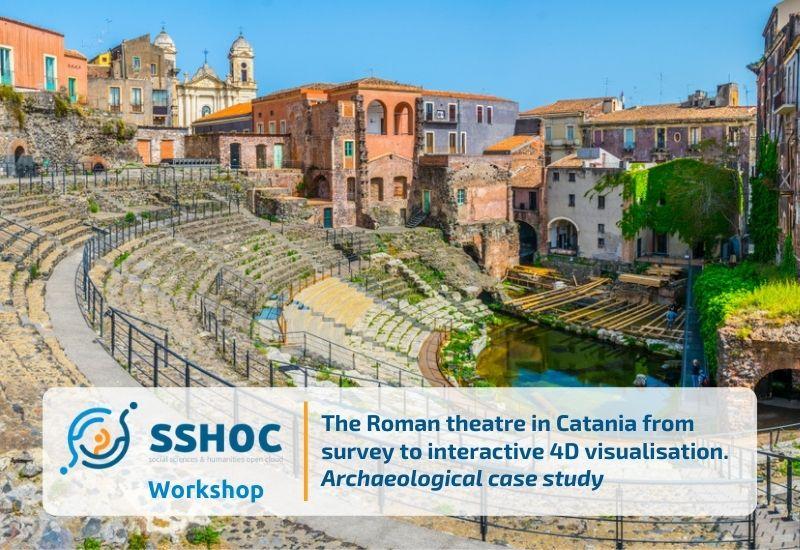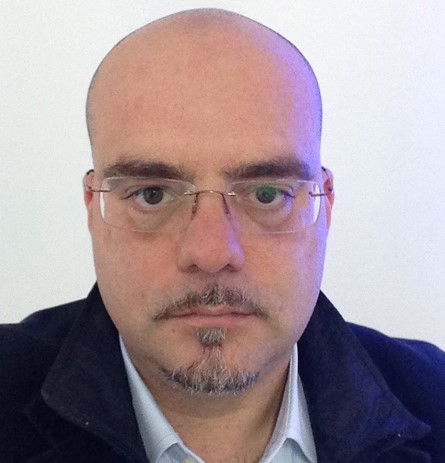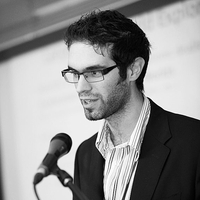
- Social Sciences & Humanities Open Cloud
SSHOC archaeological case study Workshop - The Roman theatre in Catania from survey to interactive 4D visualisation

Date:
25 May 2021 - 09:30 to 12:30
Location:
Online
Archaeological field work is a complex process in which scientific resources and competences are allocated for long periods of time, sometimes years. However, the generated data is often either not available in digital form, stuck in data silos or not public. For this reason, the sustainability of archaeological research would benefit immensely from optimized and effective systems of digital documentation, analysis and visualisation of archaeological sites as well as from public, standardised data.
In this workshop we present an archaeological case study of an actual transition of archaeological survey data from data silos to the cloud. Based on survey data of the Roman theatre in Catania, we show how the data can be visualized as an interactive virtual reconstruction of the theatre. We show how the FAIR principles and semantic modelling can be applied to archaeological data in practice by standardizing and connecting data and systems from different sources. The absence of public data is also a cultural issue since shareholders are often afraid that the data quality might not be sufficient for publishing. The workshop represents a milestone in the work of the SSHOC task 5.7, and we would like to share our experiences with the audience and vice versa.
In the first part of the workshop we present the case study as a work in progress. We look at the data and systems of the three partners, including an existing and a new visualisation of the Roman theatre and the Extended Matrix (EM) system. We conclude the first part with the integration process of systems and data that will lead to a unified workflow from survey data to an interactive 4D visualisation.
In the second part we situate the case study in the broader context of the SSHOC project and beyond. Parallel presentations will report on the FAIR principles in archaeology, the SSHOC reference ontology and the EMViq tool that accompanies the EM system. We will then discuss where to go from here and especially how to integrate the FAIR principles and the reference ontology in our work.
The workshop is aimed at archaeologists and heritage scientists with an interest in the practice of data integration, standardisation and modelling as well as data scientists and archivists with an interest in an archaeological perspective. People who just want to see a beautiful visualisation of an antique theatre are also very welcome.
Slides
The SSHOC Reference Ontology presentation
The SSHOC Reference Ontology (SSHOCro): Modeling the SSHOC data life cycle
Workshop Agenda
| Time (CEST) | Description |
| 9:30 - 10:55 |
Part 1: Work in progress09:30 Introduction to the case study and the Roman theatre in Catania (Wolfgang Schmidle, DAI, Alberto Bucciero, Emanuel Demetrescu, ISPC) 10:00 From archaeological survey to 4D visualisation
In this presentation we will describe which technologies have been used for the survey (laser scanner and digital photogrammetry) and the following virtual reconstruction process of the roman theater in Catania.
Extended Matrix is a formal language with which to keep track of virtual reconstruction processes. It is intended to be used by archaeologists and heritage specialists to document their scientific activities. It is an extension of an archaeological “Harris matrix”, which is a tool to describe the relative chronology of the elements discovered during the excavation.
The iDAI.world is a system of open access web services for archaeological data. Data services include Arachne, a large database of archaeological objects, and idai.field, a system for documenting excavation data. They are complemented by norm data services for data interoperability and standardization, notably idai.gazetteer for place-related data and ChronOntology for temporal terms. 10:40 Integrating the systems and data (Wolfgang Schmidle DAI, Alberto Bucciero, Emanuel Demetrescu, ISPC) |
| 10:55 - 11:10 |
Break |
| 11:10 - 11:45 |
Part 2: The broader context11:10 Introduction to the breakout sessions (Wolfgang Schmidle, DAI) Session 1: The SSHOC Reference Ontology (SSHOCro): Modeling the SSHOC data life cycle (Athina Kritsotaki, FORTH) The SSHOC Reference Ontology is built as an extension of CIDOC CRM and it is a workflow model. It is an event-based ontology that aims to organize knowledge and information distributed across various primary sources of information in the Social Sciences and Humanities Open Cloud. Session 2: Archaeology and the FAIR Principles (Holly Wright, ADS) Archaeology uses a broad range of digital methods and data types, and is therefore an excellent exemplar for how any complicated, heterogeneous data may be approached and made FAIR (Findable, Accessible, Interoperable and Re-usable). At the same time, Archaeology is unusual. Archaeological interventions such as excavation are non-repeatable, resulting in primary data which must be preserved beyond its life within any specific software, app, or infrastructure. This presentation will discuss the intersection between archaeology and the FAIR Principles; how it has been implemented, and what the future holds. Session 3: The EMviq tool (Bruno Fanini, ISPC) EMviq (Extended Matrix Visual Inspector and Querier) is a cross-device, online, interactive 4D visualization tool for Extended Matrices. |
|
11:45 - 12:00 |
Summary of the breakout sessions |
| 12:00 - 12:20 |
Where do we go from here (Wolfgang Schmidle DAI, Alberto Bucciero, Emanuel Demetrescu, ISPC) |
| 12:20 - 12:30 |
Open Discussion |
| 12:30 |
Closing |
Speakers

Eng. Alberto Bucciero is a researcher at Institute of Heritage Science (ISPC) of the National Research Council, based in Rome, with more than 15 years of experience in the field of Software Engineering, he carries out scientific research activities on:
- Enhanced Learning Management System based on 3D virtual environments.
- Design of mobile applications, locations and context aware based on GIS systems and GPS / RFID positioning
- Traceability and traceability systems of things and people based on RfiD technologies
- Service oriented architectures and middleware tools supporting B2B e-commerce and Supply Chain Management.
- Modeling and formalization of the requirements for the analysis of information systems designed to support business processes
Since 2006 Alberto Bucciero is also a contract professor of the University of Salento.
Since 2011 he has managed and developed the Heritage at the Territorial Information System for the Italian Cultural Heritage Laboratory (HERILAB), of the Institute for Systems and Computer Analysis " Antonio Ruberti “ (IASI).
Dr. Francesco Giuri graduated in Cultural Heritage in 2003 at the University of Salento discussing a thesis in "History of restoration". Since 2006 he has been collaborating with the ITLab - Information Technologies Laboratory of the ISPC - Institute of Heritage Science (ex IBAM - Institute for Archaeological and Monumental Heritage) of the National Research Council of Italy in Lecce, first with collaboration contracts and from 2014 as technical assistant. He has participated in several national and international projects concerning the study, survey and development of reconstructive hypotheses of monuments and archaeological sites, aimed at the knowledge, enhancement and fruition of Cultural Heritage through the use of Computer Graphics.
Emanuel Demetrescu, PhD in Archaeology, digital artist, python developer and USV pilot, is a researcher at the Institute of Heritage Science - National Research Council, Italy. Specialist in Digital Archaeology, Building Archaeology and 3D source-based modelling, his main research regards the creation of theoretical and methodological links between scientific record in Cultural Heritage and creative industries (3D digital libraries, virtual museums, Open World games and VR experiences).

Bruno Fanini, PhD in Computer Science - focuses his research and development activities on real-time 3D graphics, Virtual Reality, interaction design and 3D user interfaces at the Institute for Heritage Sciences of the National Research Council (CNR ISPC) in Italy. He developed several software tools, serious games, online virtual museums, web-applications and web services within national and international projects. He is responsible for different projects dealing with interactive 3D visualization, WebVR/XR applications, interaction models and immersive VR through head-mounted displays.

Wolfgang Schmidle is a Data Scientist at the IT Department of the German Archaeological Institute (DAI). Master in Mathematics, Bachelor in German Language and Literature and PhD in Computer Science. He has worked in the Digital Humanities since 2008. He is responsible for the design and implementation of the period gazetteer ChronOntology as part of the “iDAI.world” suite of DAI services and is currently the DAI representative in the SSHOC project as well as in the EU project E-RIHS PP and its successor IPERION HS. His research focus is the semantic modelling of data.
Holly Wright is International Projects Manager for the Archaeology Data Service, including participation in the SEADDA, ArchAIDE, NEARCH, E-RIHS, ARIADNE, ARIADNEplus, LoCloud, CARARE, and SENESCHAL projects. Her research focuses on archaeological field drawing and the Semantic Web, including specialisation in visual documentation and communication, archaeological data management, the use of Web standards and the Semantic Web in archaeology.
Athina Kritsotaki is a graduate of the department of Archaeology and Art History of the National and Kapodistrian University of Athens. She holds a Master of Science in Computer Science. Her scientific interests are focused on knowledge representation, conceptual modeling, thesauri, ontology engineering and reasoning on archaeological theories of prehistory. She has been working for the Centre of Cultural Informatics in Forth for over 15 years.
Workshop Video
